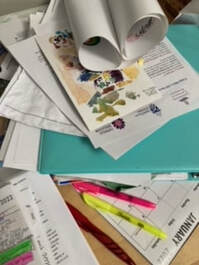 This semester, I gave my online students a new assignment. A Hmm… Collection, which I adapted from Doren and Millington (2019). I asked my students to collect and document 10 objects from their work spaces and reflect on the objects as well as the process. Halfway through grading their responses, I decided that it was only fair to do the same assignment as a way for them to get to know me a little better. Two collections emerged. The first, I realized, was something I began years earlier in the pedagogy of the home post, documenting the mess of my overlapping spaces of work, homeschool, artmaking and play.
0 Comments
And yet, perhaps one of the benefits that homeschool offers is NOT labeling activities, topics, projects as art. Or science. Or language arts. Or social studies. Or math. Perhaps just learning about things and how to do things as they are (rather than in the confines of a subject) has value.
In a research class I teach, many students describe the similarities between the action research methodology and design thinking. Or good teaching practice. Or community organizing. Or other discipline-specific thinking processes. And I say, of course. Yes. We’re simply using different words to describe the same thing. One student has been pushing back – why even bother calling it research? (And of course that question is rooted in the historic inequalities of academic research, but isn’t defining a field always rooted in keeping people out and raising some people up into positions of power)? So, this creature. The one that she spent over an hour putting together and thoughtfully placed in the guest room. What “objectives” did it meet? Or, the game that my son made up last week, spending hours setting up a new game board using the pieces of an existing game, and making up rules for how it works, blending together narrative and objectives from other video and board games and books he’s read? Or, the hours spent on imaginative play? Or, the projects I do plan on big topics like China that take on a life of their own – focusing more on reading aloud a novel that brings together the myths, beliefs, and symbols, making sense of some of the history we read about and all those things giving important context for popular culture like Disney’s Mulan? (Yes, we're back to China again. The kids love eating dumplings, and we always try new recipes and visit restaurants when we study other cultures. Isn't that a good enough reason to learn more about something?) My research in education self struggles against and within what I know/have learned as a homeschool parent. The challenge is creating spaces to document, learn from, and better create educational opportunities for my kids and my students from all these different spaces. I’ve been mulling over an idea: reconciliation as research paradigm.
Something about the process of reconciliation has stuck with me. Over the past few weeks, I’ve been reading various combinations of “reconciliation theology” “PAR and reconciliation” “research methodology and reconciliation” and “art education and reconciliation”. In the articles about reconciliation in research so far, most of what I’ve read has had to do with doing research in a different way. Especially interesting have been researchers in the quantitative paradigm working with indigenous communities, dealing with the fact that our history as researchers is entrenched in an institution shaped by colonization, racism, and a general attitude of dominance over ways of thinking, being and doing different than white, western, scientific thought. As indigenous researchers develop methodologies and bodies of research rooted in their own epistemologies and as non-indigenous researchers learn to come alongside in ways that value and respect them, how do we move forward together? In many of these articles, reconciliation is a principle, a part of a new approach to this sort of research. But, what if we centralize reconciliation? What does that make space for? What possibilities does it open? What questions does it raise for researchers – who we are, what we do, and how we do it? How does it change the aims of our research? How does it alter our practices, our questions, our methods, our publications? |
Ruth M. SmithCommunity arts educator and researcher. Drinking coffee. Home educating. Making art. Listening intentionally. Categories
All
Archives
February 2022
|

 RSS Feed
RSS Feed
